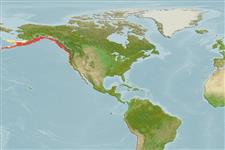Common names from other countries
Environment: milieu / climate zone / depth range / distribution range
Ecología
; rango de profundidad 2 - 300 m (Ref. 114301), usually 60 - 120 m (Ref. 114306). Temperate, preferred 7°C (Ref. 107945); 64°N - 36°N, 179°W - 120°W
Distribución
Países | Áreas FAO | Ecosistemas | Ocurrencias, apariciones | Introducciones
Eastern Pacific: From Pribilof Islands, Alaska to Point Sur, California, USA. Temperate to boreal.
Length at first maturity / Tamaño / Peso / Age
Maturity: Lm ? range ? - ? cm Max length : 28.0 cm SHL macho / no sexado; (Ref. 95344); edad máxima reportada: 15 años (Ref. 8702)
Found in small depressions on sandy-gravely substrates (Ref. 95344).
Life cycle and mating behavior
Madurez | Reproducción | Puesta | Huevos | Fecundidad | Larva
Members of the class Bivalvia are mostly gonochoric, some are protandric hermaphrodites. Life cycle: Embryos develop into free-swimming trocophore larvae, succeeded by the bivalve veliger, resembling a miniature clam.
Ignell, S. and E. Haynes. 2000. (Ref. 386)
IUCN Red List Status (Ref. 130435)
CITES status (Ref. 108899)
Not Evaluated
Not Evaluated
Human uses
Pesquerías: comercial
FAO - pesquerías: landings | FishSource | Sea Around Us
Herramientas
Fuentes de Internet
Estimates based on models
Preferred temperature
(Ref.
115969): 0.7 - 9.6, mean 5.1 (based on 348 cells).
Resiliencia
Alto, población duplicada en un tiempo mínimo inferior a 15 meses (K=0.39-0.5; tmax=15).
Vulnerability
Low to moderate vulnerability (32 of 100).
